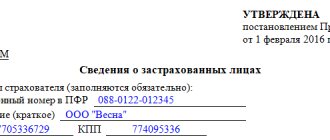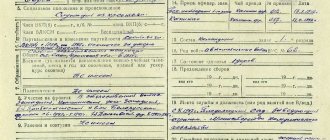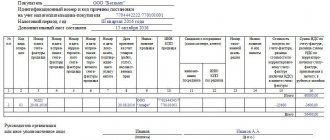Reasons for developing UPD
An invoice and any of the primary documents (for example, an invoice) include the same data, so they are duplicated. It was decided to create a new document to reduce the time frame required to search and process information. But the opportunity to make a new form appeared only in 2013, since earlier legislation required the use of identical primary forms.
The new law “On Accounting” No. 402-FZ was issued in December 2011. For discussion among forum members of the community for accountants, a draft of the future document was posted on the website of the Federal Tax Service of the Russian Federation. Initially, its name sounded like a single shipping document, then it was adjusted. Therefore, deciphering the UTD in accounting began to sound like a universal transfer document.
To create the form, the Federal Tax Service attracted specialists who had previously developed 1C applications. At the end of October 2013, the final version was published on the official portal of the Federal Tax Service. From that time on it was allowed to be used. Additionally, tax officials attached a letter that explained for which transactions the UTD is used, how to prepare a universal transfer document and fill out its individual columns.
https://youtu.be/HTHE3OqlETI
What form should you use?
The sample format and rules for filling out the UTD in 2020 are enshrined in the Letter of the Federal Tax Service MMV-20-3 / [email protected] The universal deed of transfer is an independent document; when filling it out, you need to focus not only on the standards of the tax service, but also on Federal Law No. 402 -FZ and RF PP No. 1137 dated December 26, 2011, which provides the procedure for generating information in the invoice.
The form is formed by analogy with the primary invoice, so the transfer deed contains all the same details. The Contractor has the right to add new lines or cells for additional information. If the supplier uses both an invoice and a UPD, then he must bring both documents into full compliance. All additional information in the invoice must be duplicated in the universal transfer document.
This is not a unified form, but it is advisory in nature. Each organization has the right to modify the form of the universal transfer act to suit its specifics and the conditions of a specific government contract. Follow the rules for invoices: you can add cells, you cannot remove them. The UPD must contain all the same details that 402-FZ obliges to indicate in the primary registers (Article 9 402-FZ).
What is the document for?
A universal transfer document is an alternative form that combines a delivery note for goods or a certificate of work performed and an invoice. On its basis, accounting is carried out, tax expenses are written off, and VAT deductions are claimed. The document contains all the functions assigned to the primary office, which are necessary for accounting in accounting and in the Federal Tax Service.
Tax legislation contains the following provisions for determining VAT deductions. For this you need:
- Invoice. On its basis, the buyer accepts property rights to services and goods. According to the document, the tax amounts are determined.
- Source documents. They become the basis for VAT payments after services and goods are registered.
When calculating income tax, the primary account plays the following role:
- Expenses are confirmed only if there is documentation drawn up in accordance with the legislation of the Russian Federation. That is, UPD is perfect for this purpose.
- Tax accounting data is also confirmed by the presence of primary accounting documentation.
UPD has functions that allow it to be used for all types of reporting.
According to the law, the following details must be indicated in the primary documentation:
- document's name;
- day, month, year when the document was issued;
- the full name of the organization or passport details of the individual entrepreneur who took part in the preparation of the documentation;
- name of product or service;
- the size or cost of products and services received;
- position of the person responsible for the transaction;
- Full name, signature and other details of the persons responsible for the transaction and documentation.
Primary forms must be approved by the company's management. Documentation can be drawn up on paper and electronically. An electronic signature is placed on the virtual documentation.
Algorithm of work using UPD
The universal transfer act is filled out by suppliers.
If the parties work according to the old scheme, then the order of their interaction is as follows: the contractor ships goods or performs work or services, after which the customer accepts them. If there are no complaints, sign the delivery note or act. Only after signing the documentation confirming the fact of delivery, payment registers are issued - an invoice and an invoice for tax purposes.
You can also work according to a simplified version. A universal deed of transfer combines the functionality of several primary documents. Some suppliers combine the details of the invoice and the delivery note or certificate of work performed in the form. If the customer has no claims to the goods shipped, work performed and services provided by the supplier, then he signs the UPD and pays immediately, without waiting for a separate settlement register to be issued.
Using UPD
UPD can replace a traditional invoice or they can be used together. The basis for creating a universal transfer document was the invoice, to which additional columns specified in the legislation were added.
When the UPD is set:
- when receiving/transferring products;
- when shipping products by an intermediary;
- when providing various types of services;
- when transferring property rights or the results of work performed.
We have found out why a UTD (universal transfer document) is needed, but the question arises: is its use mandatory? The legislation states that you can use other forms, information about which can be found in Article 9 of Law No. 402-FZ. UPD was created only to simplify the work of accountants and reduce document flow.
What details are included in the document?
The largest part of the document is occupied by the invoice, which is entered unchanged into the UPD. It is outlined with a thick line. The document also contains mandatory UPD details, which are specified in Law No. 402-FZ:
- The exact name of the document (universal transfer document).
- The date the document was drawn up (day, month, year). This date must coincide with the date of the invoice.
- In fields 14 and 19 the name of the economic entity that compiled the documentation is written.
- Indication of facts of economic life (information about shipment, transfer of goods, provision of services, performance of work).
- The cost of goods and services or an indication of the value (volume). Units of measurement must be indicated.
- The position of the person who is responsible for completing and finalizing the transaction. Columns 10 and 13 are filled in by the seller, and 15 and 18 by the buyer.
- Signatures of persons responsible for the transaction. Their last names and initials are indicated.
Who signs the UPD (responsible for the correct registration of the fact)?
On the seller's side, this will be the person responsible for maintaining documentation. He signs in paragraph 13. And in line 10, the person who shipped the goods (driver, forwarder, loader, etc.) signs. On the buyer’s side, signatures are placed in the same way: in line 18, he or several persons responsible for the transaction sign, and in column 15 the buyer himself or the person who has the authority to do so signs. Those who have the right to sign are determined in advance by the head of the enterprise.
What is a universal transfer document? Purpose and form of filling out the UPD
A universal transfer document is a document that is issued when transferring services, work, property rights or shipping goods and combines an invoice and transfer documents (acts, delivery notes, etc.). The UPD form was developed by the Federal Tax Service of Russia (Appendix 1 to the Letter of the Federal Tax Service dated October 21, 2013 No. ММВ-20-3/96). The document contains three types of details:
- details of the universal transfer document;
- details of the primary accounting document;
- invoice details.
The document form is recommended - it can be modified by adding the necessary columns and columns. You cannot remove details from the form.
The UPD is not a mandatory document. Organizations and entrepreneurs have the right to use it or adhere to the usual rules for preparing primary documentation and issue invoices and transfer documents separately. The use of a universal transfer document simplifies and speeds up the process of primary document management, tax and accounting, and reduces the risk of errors, because instead of two documents, only one is drawn up.
UPD form in 2020
From January 1, 2020, all companies exchanging electronic documents must submit UTD in the new format approved by the Federal Tax Service order dated December 19, 2018 No. ММВ-7-15/ [email protected] Documents in the old format approved by the Federal Tax Service order dated March 24, 2016 No. ММВ-7-15/ [email protected] are no longer accepted. The only exception is for UPD issued before 2020 - they will be accepted in electronic form until the end of 2022 (and then only in printed format).
Status 1 and 2 in UPD
The UPD has a “Status” column. You can put the number 1 or 2 in the value. Let's consider how UTDs with status 1 and 2 differ. It is important to remember the values so as not to get confused in the future when preparing documentation.
UPD status 1 is a document used simultaneously as a primary document and an invoice. That is, it serves as the basis for withholding VAT and there is no additional need to create an invoice.
What does UPD status 2 mean? This means that the document can only be used as primary documentation. Such a document is convenient to use for persons who use a simplified form of taxation. Since it does not oblige the “simplified” person to pay VAT upon receipt of the UTD. In addition, UTD with status 2 is used when shipping goods to intermediaries.
When a document is applied with status 2, the following fields need not be filled in:
- excise tax amount;
- tax rate;
- barcode of the country from which the goods arrived;
- to the payment and settlement document (No.... from...);
- country of origin of the goods;
- Customs declaration no.
The universal transfer document with statuses 1 and 2 has significant differences in use, so it is important not to confuse the values when filling out the details. If by chance a mistake was made: instead of status 1, status 2 was indicated, but the details were filled out as for the first status, then you can make a correction directly on the form. To do this, one number is crossed out and another is written. The correction is certified by the signature of the person responsible for the correctness of the documentation.
If errors were made when filling out the UPD with status 2, these can also be corrected. True, accounting legislation does not provide clear recommendations in this regard. It is only indicated that next to the correction the name and signature of the employees responsible for the correct completion of the documentation are placed. But you can simply print a new document with the correct data.
You cannot edit a document with status 1 by hand. A new corrected document must be submitted, and in field 1a the number and date when the corrections were made are written down.
Without which the UPD cannot be compiled
Since 2013, the mandatory use of unified document forms has been abolished. This means that they can be taken as a basis, but supplemented or adjusted to suit the needs of the company/individual entrepreneur. the required must be preserved in the document .
Since the UPD combines the functions of a primary accounting document and an invoice, it must contain mandatory details - both the primary accounting document and the invoice. What these details are is reflected in the diagram below (Article 9 of Law No. 402, paragraph 5 of Article 169 of the Tax Code of the Russian Federation):
Universal transfer document number
How to assign a UPD number? When assigning a UPD number, you should pay attention to its status. Assigning an invoice number is regulated by the tax legislation of the Russian Federation. When issuing it, you must enter the invoice number in the first line, which is assigned in chronological order. The law also defines the principle of numbering documentation by enterprise divisions.
If the UPD is used only as a primary device, then it is not necessary to assign a number to it. It can be concluded that:
- if the UPD has status 1, its number depends on the number of the previous invoice, that is, it will be next in order;
- if the document has status 2, then a number can be assigned to it in the same way as is done at the enterprise for invoices or work certificates.
How to fill out the UPD date
In the recommended form of the universal transfer document we see three dates:
- line (1) - date of document preparation;
- line [11] - date of the fact of economic activity (date of actual shipment of goods, transfer of work results to the customer, presentation of a document on the provision of services, transfer of property rights);
- line [16] - date of receipt of goods, acceptance of work results, provision of services, receipt of property rights.
Let's remember how the legislation links the date of drawing up the invoice , the moment of determining the tax base and the emergence of the buyer's right to deduct. In accordance with paragraph 5 of Article 169 of the Tax Code of the Russian Federation, paragraph “a”, paragraph 1 of the Rules for filling out invoices:
- the invoice must be issued no later than 5 calendar days from the date of shipment of goods (performance of work, provision of services), transfer of property rights;
- an invoice issued before the date of shipment (before the preparation of primary documents confirming shipment) cannot be the basis for a deduction (letters of the Ministry of Finance of the Russian Federation dated November 9, 2011 No. 03-07-09/39, dated February 17, 2011 No. 03-07- 08/44);
- The moment of determining the VAT tax base for work should be the date of signing the work acceptance certificate by the customer (letter of the Ministry of Finance of the Russian Federation dated March 16, 2011 No. 03-03-06/1/141, dated October 7, 2008 No. 03-07-11/328) .
According to Part 3 of Art. 9 of Law No. 402-FZ, the primary accounting document must be drawn up when the fact of economic activity is committed, and if impossible, immediately after its completion.
Let us now consider the possible options for putting dates in the transfer document:
- The UPD is compiled at the time of the fact of economic activity (shipment of goods, transfer of work, services, property rights). There may well be an “ideal option” when the date of drawing up the document, the dates of shipment and acceptance of goods coincide, then the indicators of lines 1, 11 and 16 correspondingly coincide.
- The date of drawing up the document and the date of shipment may coincide, that is, lines 1 and 11 coincide, and the date of acceptance, that is, page 16, will be later.
In these cases, the moment of determining the tax base for VAT will be the date indicated in lines 1 and 11, and for work - in line 16.
- The UPD can be compiled before the fact of economic activity (before shipment of goods, transfer), then the chronology of events will look like this:
1. preparation of the document - the date indicated in line 1;
2. shipment - date indicated in line 11;
3. acceptance - date indicated in line 16.
The moment of determining the tax base for VAT will be the date indicated in line 11, and for work - in line 16.
A situation may arise when it was not possible to draw up a document when committing a fact of economic activity, and the UPD was drawn up immediately after its completion (in the cases provided for in paragraph 3 of Article 9 of Law No. 402-FZ), then the chronology of events will look like this:
1. shipment - date indicated in line 11;
2. preparation of the document - the date indicated in line 1;
3. acceptance - date indicated in line 16.
The moment of determining the tax base for VAT will be the date indicated in line 11, and for work - in line 16. As for the buyer, he has the right to claim a VAT deduction no earlier than the date of receipt of the goods or the date of acceptance of work indicated in line 16.
Filling in the date
The universal transfer document has three fields for filling in the date. Therefore, the question arises: how to fill out the UPD date and what to enter on each line? In line number 1, enter the date when the document was drawn up. In line number 11 you need to enter the date when the fact of economic life occurred (products were shipped, the transfer of property rights began, etc.) In line 16 you need to enter the date of receipt of goods or services, acceptance of work that was completed earlier.
According to the law, the date of leaving the UTD is linked to the emergence of the buyer’s rights to deduction. The rules for preparing invoices are:
- You cannot issue an invoice later than five days after the provision of services, shipment of products, etc.;
- if the document was drawn up before shipment, then it has no force and cannot be considered a basis for a deduction;
- if the VAT tax base is determined upon delivery of the work performed, then this will be the date the act is signed by the customer.
The third part of Article 9 of Federal Law No. 402 states that the UPD is drawn up at the moment when a fact of economic life occurs. But if this cannot be done, then it can be drawn up after the completion of shipment of products or completion of work. Therefore, dates in the document can be entered as follows:
- all operations can be performed on the same day, so the dates in lines 1, 11 and 16 will be the same;
- the date of preparation of documentation and shipment of products may be the same, but acceptance of goods or work may take place several days later, that is, line 16 will have a different date.
For the shipment of goods, the date for determining the tax base must be looked at in lines 1 and 11, but if we are talking about the completion of work, then the date set in line 16 will be decisive. When the UPD came into force, all these points were reflected in the tax legislation.
If it was not possible to draw up the UTD before the completion of the fact of economic life, then to determine the tax base, the date entered in field number 11 is taken (for work - in field 16). But the buyer may well claim a VAT deduction according to the date in line 16, since it was during this period that he received the goods or accepted the completion certificate.
Difficulties for the buyer
The buyer may experience difficulties with the following lines:
| Line No. 15 | The position of the person involved in receiving the cargo or receiving the results of the work performed is indicated. |
| Line No. 16 | The actual date of receipt of the goods or acceptance of the work results is indicated. |
| Line No. 17 | The position of the person responsible on the part of the consumer for the correctness of the transaction is recorded, as well as his personal signature. |
| Line No. 18 | The position of the person responsible on the part of the consumer for the correctness of the transaction is recorded. The person must sign his/her signature with mandatory decoding. |
| Line No. 19 | The name of the organization involved in filling out the document on behalf of the consumer is given. In particular, the name of the company that is responsible for maintaining accounting records in the organization in accordance with the concluded agreement may be indicated. |
https://youtu.be/F10BLpyFvvw
Signatures in the UPD
Let's consider who should sign the UPD, in which lines the signatures of authorized persons are placed.
The fields where the manager or chief accountant must sign must always be filled out. Even for documents with status 2, no exceptions are made.
In field number 10, the full name and signature are placed, as well as the position of the person who shipped the products or is responsible for signing acts upon completion of work or services provided. This person may be simultaneously authorized to sign the invoice, so then he can simply write his position and full name without signing.
In field number 13, the details of the official (on the seller’s side) who is responsible for preparing the documentation confirming the fact of economic life are indicated. If the same person is indicated in lines 10 and 13, then the second time he does not have to sign.
In field number 15, the person who received the goods or has the right to sign certificates of completion of work (provision of services) enters their initials, surname, and position.
In field number 18, the person responsible for completing the documentation on the buyer’s side signs. He also enters his initials and position. He may not sign again if he himself accepted the goods.
In 2013, legislation tightened the requirements for primary education. According to the amendment to No. 402-FZ, it is impossible to accept for accounting documentation that reflects false or unfulfilled
Legislative regulation of its application
All legal entities and individuals in the Russian Federation who receive income (regardless of its sources) are required to pay taxes to the state treasury. This rule is the same for everyone; its compliance is monitored by the Federal Tax Service (FTS).
Therefore, documentary recording of business transactions carried out by individuals. or legal entities, is mandatory and regulated at the federal level.
A universal transfer document is a document necessary for the buyer to accept goods (services), as well as property rights.
In addition, this document allows you to calculate and submit VAT (value added tax) for deduction (you can read more about this in another article on our blog, which can be accessed using the link provided).
The purpose and rules for filling out the UPD are specified in the Letter of the Federal Tax Service of Russia dated October 21, 2013 No. ММВ-20-3/ [email protected] This document also approves the voluntary principle of using the UPD. Instead (as before 2013), you can use an invoice + a primary document for a product (service).
Is it necessary to put a stamp on the UPD?
There is no need to put a stamp on the UPD. In 2002, it was excluded from the mandatory details for invoices. Initially, seals were not provided for primary materials. Therefore, its absence will not in any way affect the deduction of VAT or confirmation of expenses.
But if the seal of both parties (seller and buyer) is still on the document, then there is no need to fill out fields number 14 and 19. Line 14 contains information about the economic entity that compiled the document (seller, executor, agent, accountant) . In line 19 similar data is entered, but from the buyer’s side.
Universal transfer document (UTD) from July 1, 2020: completed sample
Many accountants have heard that the universal transfer document (UTD) and the sample for filling it out have changed since July 1, 2020.
Is it true? Is a new UPD form required or recommended, which includes the details of the invoice and delivery note? Let's answer these and other questions.
You can also download a free completed sample form of a universal transfer document, which can be used from July 1, 2020 (using the new form). When shipping goods or transferring works, services, property rights, taxpayers have the right not to issue an invoice and a transfer document (bill of lading, act, etc.) as independent documents. These documents can be summarized into one universal transfer document (UTD).
The form of a universal transfer document developed by the Federal Tax Service of Russia is an invoice supplemented with details of primary accounting documents confirming the transfer of inventory assets (property rights), delivery and acceptance of work (services).
The background is given in the Letter of the Federal Tax Service dated October 21, 2013 No. ММВ-20-3/96. You can download the UPD form, which was used until 07/01/2017. In the form of a universal transfer document proposed by the Federal Tax Service of Russia, three groups of details can be distinguished:
- invoice details;
- details of the primary accounting document.
- details specific only to the UPD form;
It is important to say that the UPD form is recommended, not mandatory.
Therefore, it can be supplemented with new columns or lines.
In this case, the universal transfer document does not have to be drawn up on paper.
It can also be compiled electronically. The format of the UPD (including an invoice) in electronic form was approved by Order of the Federal Tax Service of Russia dated March 24, 2016 No. ММВ-7-15/155. Next, let's look at what exactly changes from July 1, 2020.
From July 1, 2020, a new invoice form must be used. The updated form has been supplemented with a new line in which sellers write down the identifier of the government contract (Resolution of the Government of the Russian Federation dated May 25, 2017 No. 625).
Fields are optional
There are many additional fields in the UPD that do not need to be filled in, but in some cases, filling them out is useful for the seller and the buyer. These include:
- Subscription number (field A). The number in order is placed in the table solely for convenience when filling it out.
- Product/service code (field B). To be filled in if the product is shipped to another country, or when preferential tariffs are used. Where can I get the code of goods, works, services in the UPD? You can view it in the unified Commodity Nomenclature of Foreign Economic Activity of the EAEU.
- Field 8. It indicates the numbers of contracts and cooperation agreements of the parties. This helps to find out the terms of the transaction directly from the source.
- Field 9. It contains the parameters of the cargo, special instructions to the forwarder, and details of the waybills, but this is not done at every enterprise.
- Field 12. Additional information about the product (passport or certificate numbers) is entered here; special information regarding the transaction can also be entered in this column.
- Field 17. It is intended for entering claims or information about documents drawn up by the buyer (recipient of the service).
Filling out UPD in 1C
1C users can also generate a universal transfer document that replaces the acceptance certificate, invoice and primary document directly in the program.
How to write out UPD in 1C 8.3:
- We go to the sales menu, then go to the sales section (invoices, acts).
- Enter the implementation document number.
- Select to issue an invoice and click on the “Post” button.
- Click on the inscription “Print” and select UPD.
You can print a universal transfer document only with status 1. The program will fill in most of the fields on its own, but you will have to enter some data yourself by turning on the editing mode.
If by chance an error was made in the UPD, then you need to make an adjustment to the implementation based on the document. Operation: correction in the primary. First, adjustments are made, then the invoice is registered for correction. Then a print form is selected, where you need to click on the corrected version.
Instructions for working with 1C
In programs 1C 7.7 or 8.2, UPD is an element of printed forms for documents, as well as issued invoices for sale. Printing of the UPOD with status “1” is carried out on the basis of the invoice registered for shipping documentation in the information base.
To carry out this operation, you need to select the “Universal transfer document” item, after which the program will automatically fill in the details according to the information in the accounting system, but in the future you will still have to manually edit some indicators.
If an error is found in the document, then in this case you will need to use the “Implementation Correction” function on the desired document, setting the type of operation as “Correction in primary documents”.
Sample UPD in 1C
Storage and registration of documentation
Business accountants are wondering where to store UPD? Should they be put in the folder with invoices, or with the primary receipt? Experts believe that it is better to store the UTD separately from the rest of the documentation. This will be convenient, especially if the company has recently switched to using universal transfer documents. In a separate folder, the required UPD can be found faster during checks.
The seller records the UTD in the accounting journal where invoices issued and received are recorded. Its number is recorded in part 1.
The buyer enters the UPD in part 2 of the accounting journal.
What information is displayed in the UPD
The UPD universal transfer document contains the same information that appears on the invoice.
In addition, it contains fields and sections in which product codes, services according to KVED or OKUN are necessarily displayed, including all the necessary information regarding the transportation or transfer of products and so on.
Taxpayers have every right to indicate in the form other values that are necessary according to their work activities.
It is important to remember: it is strictly forbidden to remove any mandatory details from the document.








